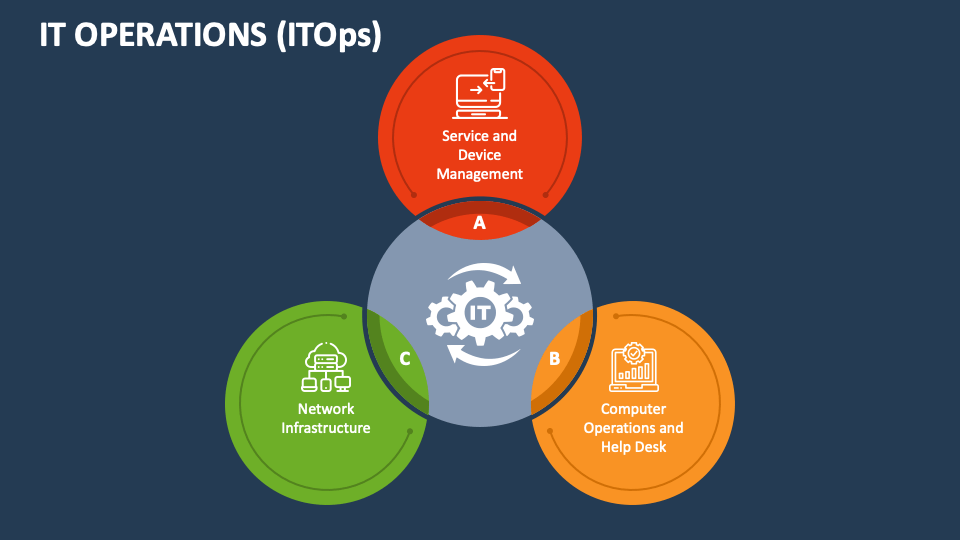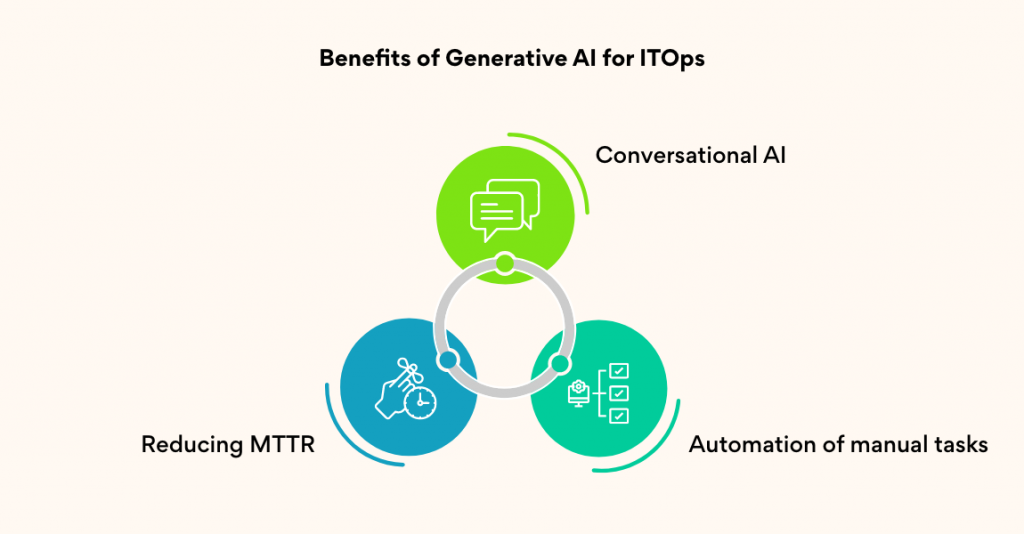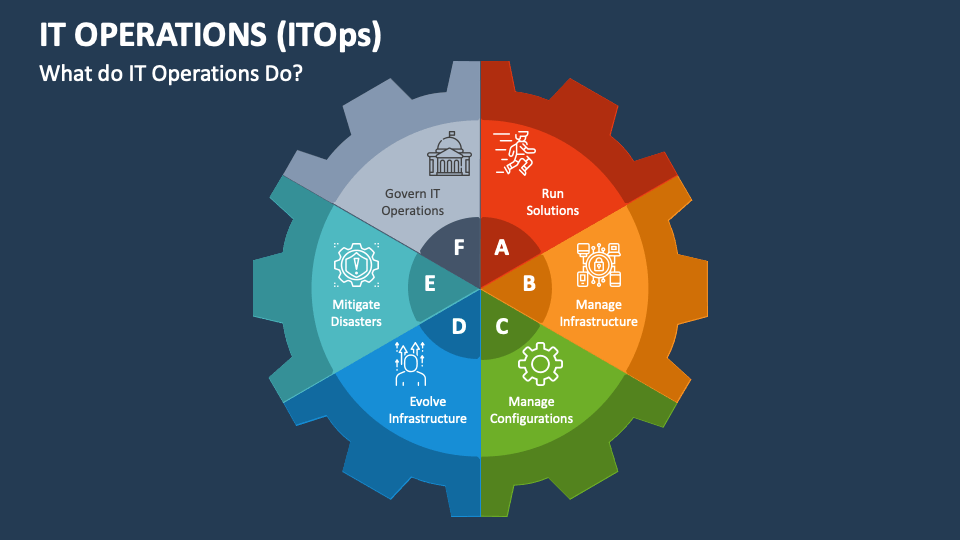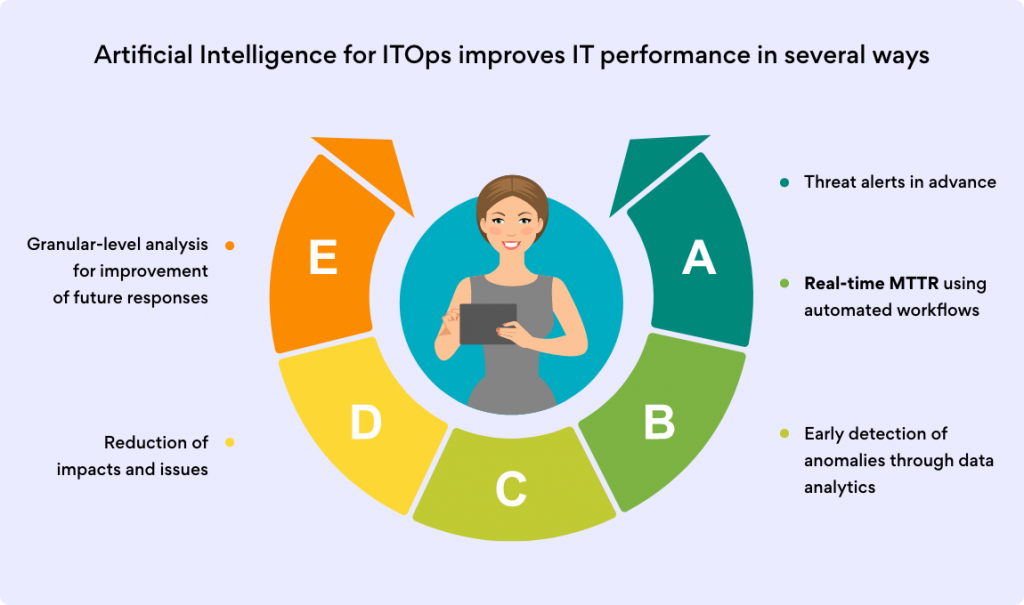
ITOps (Information Technology Operations) refers to the set of practices and processes involved in managing and maintaining an organization’s IT infrastructure, systems, applications, and services. ITOps is responsible for ensuring the availability, performance, and reliability of IT resources to support business operations.
ITOps encompasses a wide range of activities, including monitoring, incident management, capacity planning, configuration management, performance optimization, security management, and more. The goal of ITOps is to ensure that IT services are delivered efficiently, securely, and in alignment with business needs.
Key Aspects of ITOps:
- Infrastructure Management: ITOps involves managing physical and virtual infrastructure, including servers, networks, storage, and data centers.
- Application Management: ITOps is responsible for deploying, monitoring, and maintaining applications to ensure their availability and performance.
- Incident Management: ITOps handles the identification, analysis, and resolution of IT incidents to minimize service disruptions.
- Monitoring and Alerting: ITOps monitors IT systems, applications, and services to proactively detect issues and respond to them in a timely manner.
- Performance Optimization: ITOps optimizes the performance of IT resources to ensure optimal efficiency and responsiveness.
- Security Management: ITOps implements security measures to protect IT assets from threats, vulnerabilities, and unauthorized access.
- Backup and Recovery: ITOps establishes backup and recovery processes to ensure data integrity and facilitate disaster recovery.
- Configuration Management: ITOps maintains a consistent and up-to-date configuration of IT assets to prevent configuration drift and inconsistencies.
- Patch and Update Management: ITOps applies patches, updates, and software upgrades to keep systems secure and up-to-date.
Why Do We Need ITOps?
- Service Availability: ITOps ensures that IT services are available and accessible to users, minimizing downtime and disruptions.
- Business Continuity: ITOps helps maintain business continuity by providing resilient IT systems and disaster recovery capabilities.
- Performance Optimization: ITOps optimizes the performance of IT resources, ensuring that systems operate efficiently and respond promptly.
- Risk Management: ITOps mitigates risks associated with IT failures, security breaches, and data loss.
- Security and Compliance: ITOps implements security measures to protect IT assets and ensures compliance with industry regulations.
- Problem Resolution: ITOps identifies and resolves IT issues, minimizing their impact on business operations.
- Capacity Planning: ITOps performs capacity planning to ensure that IT resources can handle the workload and demand.
- Cost Efficiency: ITOps optimizes resource utilization to reduce costs associated with IT infrastructure and operations.
- User Satisfaction: ITOps contributes to user satisfaction by maintaining reliable and responsive IT services.
- Data Integrity: ITOps ensures data integrity and availability through backup, recovery, and data management practices.
- Innovation Support: ITOps provides a stable and secure platform for innovation by maintaining a reliable IT environment.
- Resource Management: ITOps efficiently manages IT resources, preventing overprovisioning and unnecessary expenses.
ITOps plays a critical role in managing and maintaining IT infrastructure, applications, and services to ensure their availability, reliability, and security. It supports business operations, mitigates risks, and contributes to the overall efficiency and effectiveness of an organization’s IT operations.
What is the Advantage of ITOps?

- Service Availability: ITOps ensures that IT services are available and accessible to users, minimizing downtime and disruptions.
- Business Continuity: ITOps helps maintain business continuity by providing resilient IT systems and disaster recovery capabilities.
- Performance Optimization: ITOps optimizes the performance of IT resources, ensuring that systems operate efficiently and respond promptly.
- Risk Management: ITOps mitigates risks associated with IT failures, security breaches, and data loss.
- Security and Compliance: ITOps implements security measures to protect IT assets and ensures compliance with industry regulations.
- Problem Resolution: ITOps identifies and resolves IT issues, minimizing their impact on business operations.
- Capacity Planning: ITOps performs capacity planning to ensure that IT resources can handle the workload and demand.
- Cost Efficiency: ITOps optimizes resource utilization to reduce costs associated with IT infrastructure and operations.
- User Satisfaction: ITOps contributes to user satisfaction by maintaining reliable and responsive IT services.
- Data Integrity: ITOps ensures data integrity and availability through backup, recovery, and data management practices.
- Innovation Support: ITOps provides a stable and secure platform for innovation by maintaining a reliable IT environment.
- Resource Management: ITOps efficiently manages IT resources, preventing overprovisioning and unnecessary expenses.
What is the feature of ITOps?
- Infrastructure Management: ITOps manages physical and virtual infrastructure, ensuring hardware and software components work together efficiently.
- Application Management: ITOps oversees application deployment, monitoring, and maintenance to ensure their optimal performance.
- Incident Management: ITOps identifies and responds to IT incidents, minimizing their impact on operations and user experience.
- Monitoring and Alerting: ITOps monitors IT systems and services, using alerts to proactively detect and address issues.
- Performance Optimization: ITOps optimizes system and application performance for optimal responsiveness.
- Security Management: ITOps implements security measures to protect IT assets from threats, vulnerabilities, and unauthorized access.
- Backup and Recovery: ITOps establishes backup and recovery processes to ensure data integrity and disaster recovery capabilities.
- Configuration Management: ITOps maintains consistent and up-to-date configurations to prevent inconsistencies and drift.
- Patch and Update Management: ITOps applies patches, updates, and software upgrades to keep systems secure and up-to-date.
- Capacity Planning: ITOps plans for capacity needs to ensure IT resources can handle expected workloads.
- Problem Resolution: ITOps troubleshoots and resolves IT issues to minimize disruptions and downtime.
- Automation: ITOps employs automation to streamline repetitive tasks and improve operational efficiency.
- Change Management: ITOps manages changes to IT systems and infrastructure to minimize risks and ensure stability.
- Monitoring and Reporting: ITOps provides monitoring and reporting tools to track performance, incidents, and trends.
- Collaboration: ITOps collaborates with other teams, including development and security, to ensure a holistic approach to IT management.
ITOps offers various advantages by ensuring the availability, reliability, and security of IT infrastructure and services. Its features encompass a range of practices and processes that support efficient and effective IT operations, ultimately contributing to the success of an organization’s business objectives.
What is the Top 10 Use cases of ITOps?

Some of the top 10 use cases of ITOps:
- Infrastructure as code (IaC): ITOps can use IaC to automate the provisioning and configuration of infrastructure resources. This can help to improve the efficiency and reliability of IT operations.
- Configuration management: ITOps can use configuration management to track and manage the configuration of IT assets. This can help to ensure that IT assets are compliant with organizational policies and standards.
- Change management: ITOps can use change management to control and manage changes to IT systems. This can help to minimize the risk of disruptions to IT services.
- Incident management: ITOps can use incident management to resolve IT incidents quickly and efficiently. This can help to minimize the impact of IT incidents on business operations.
- Problem management: ITOps can use problem management to identify and resolve the root causes of IT problems. This may help to prevent future problems from happening.
- Service level management (SLM): ITOps can use SLM to define, measure, and manage the performance of IT services. This can help to ensure that IT services meet the needs of business users.
- Capacity planning: ITOps can use capacity planning to ensure that IT resources are available to meet the needs of business users. This can help to avoid performance problems and outages.
- Security: ITOps can use security measures to protect IT systems from unauthorized access, use, or modification. This can help to protect sensitive data and systems from cyber attacks.
- Compliance: ITOps can use compliance measures to ensure that IT systems comply with organizational policies and external regulations. This can aid in avoiding penalties and fines.
- Reporting and analytics: ITOps can use reporting and analytics to track the performance of IT operations and identify areas for improvement. This can help to make informed decisions about IT investments and operations.
How to Implement ITOps?
Here are the steps involved in implementing ITOps:
- Define your goals: The first step is to define your goals for ITOps. What do you want to achieve by implementing ITOps? Do you want to improve efficiency, reliability, security, or compliance?
- Assess your current state: The next step is to assess your current state of IT operations. What are your strengths and weaknesses? What are your biggest challenges?
- Choose the right tools and technologies: There are a number of tools and technologies available for ITOps. Choose the tools and technologies that are right for your needs and that will help you achieve your goals.
- Implement the tools and technologies: The next step is to implement the tools and technologies that you have chosen. This may involve training your staff on how to use the new tools and technologies.
- Monitor and improve: The final step is to monitor and improve your ITOps practices. This involves collecting data on the performance of IT operations and using this data to identify areas for improvement.
Implementing ITOps can be a complex and challenging undertaking, but it can be very rewarding. By following these steps, you can implement ITOps and achieve your goals.
How to Get certified in ITOps?
- DevOpsSchool.com
- scmGalaxy.com
- BestDevOps.com
- Cotocus.com

There are a few ways to get certified in ITOps. Here are some of the options:
- Take a course: There are many online and in-person courses available that teach the fundamentals of ITOps. These courses can help you learn the key concepts and principles of ITOps, as well as the tools and technologies used in this field.
- Get certified by a vendor: There are a number of vendors that offer ITOps certifications. These certifications can be a good way to demonstrate your skills and knowledge to potential employers.
- Contribute to an open source project: There are many open source projects that are related to ITOps. Contributing to these projects can help you learn about the practical application of ITOps concepts and technologies.
- Get a job in ITOps: One of the best ways to learn ITOps is to get a job in this field. This will give you the opportunity to work with experienced ITOps professionals and learn from them.
Here are some of the resources that you can consider for learning ITOps:
- Books and articles: There are many books and articles available that discuss ITOps. These resources can help you learn more about the history of ITOps, the different approaches to ITOps, and the challenges and opportunities that ITOps presents.
- Online courses: There are many online courses available that teach the fundamentals of ITOps. These courses can help you learn the key concepts and principles of ITOps, as well as the tools and technologies used in this field.
- Conferences and meetups: There are many conferences and meetups that focus on ITOps. These events can be a great way to learn about the latest trends in ITOps, network with other ITOps professionals, and get hands-on experience with ITOps tools and technologies.
- Get involved in open source projects: There are many open source projects that are related to ITOps. Getting involved in these projects can help you learn about the practical application of ITOps concepts and technologies.
- Contribute to an ITOps community: There are many online communities and forums where ITOps professionals discuss their work. Joining these communities can be a great way to learn from others, get help with your own work, and stay up-to-date on the latest developments in ITOps.
How to Learn ITOps?

The best way to learn ITOps is to find a combination of methods that works for you. Some people prefer to take courses, while others prefer to read books and articles. Some people prefer to attend conferences and meetups, while others prefer to get involved in open source projects or contribute to ITOps communities. The most important thing is to find a way to learn that is engaging and that helps you retain the information.
The following are the additional tips for learning ITOps:
- Start with the basics: Before you dive into the more advanced topics, make sure you understand the basics of IT operations, such as infrastructure as code, configuration management, and change management.
- Find a mentor: A mentor can be a great way to learn ITOps. They can supply assistance and support, and they can assist you in troubleshooting problems.
- Be patient: Learning ITOps takes time and effort. Don’t get distured if you don’t understand everything in the right manner. Just keep learning and practicing, and you will eventually master the concepts and technologies of ITOps.
- Why Can’t I Make Create A New Folder on External Drive on Mac – Solved - April 28, 2024
- Tips on How to Become a DevOps Engineer - April 28, 2024
- Computer Programming Education Requirements – What You Need to Know - April 28, 2024

